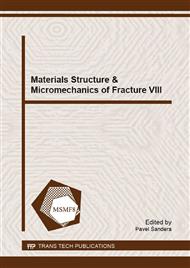p.489
p.495
p.501
p.506
p.514
p.518
p.522
p.526
p.530
Criteria for Prediction the Interfacial Crack Growth in Concrete
Abstract:
To understand the mechanical behavior of the concrete structures, one must analyze deformation and fracture of the interfaces between the constituents of the material that the structure is made of. Criteria for predicting the crack growth along an interface, based on the linear elastic fracture mechanics concept, applied for the cement substrate/aggregate interface, are presented in this paper. The two possible directions of the interfacial crack growth – the crack propagation along the interface and the crack kinking away from the interface are considered, with the corresponding energy release rates. For the case of the crack approaching the interface from one of the materials – cement, the competition between the crack deflecting into the interface and the crack penetrating the interface is considered with the corresponding energy release rates.
Info:
Periodical:
Pages:
514-517
Citation:
Online since:
December 2016
Authors:
Price:
Сopyright:
© 2017 Trans Tech Publications Ltd. All Rights Reserved
Share:
Citation:


